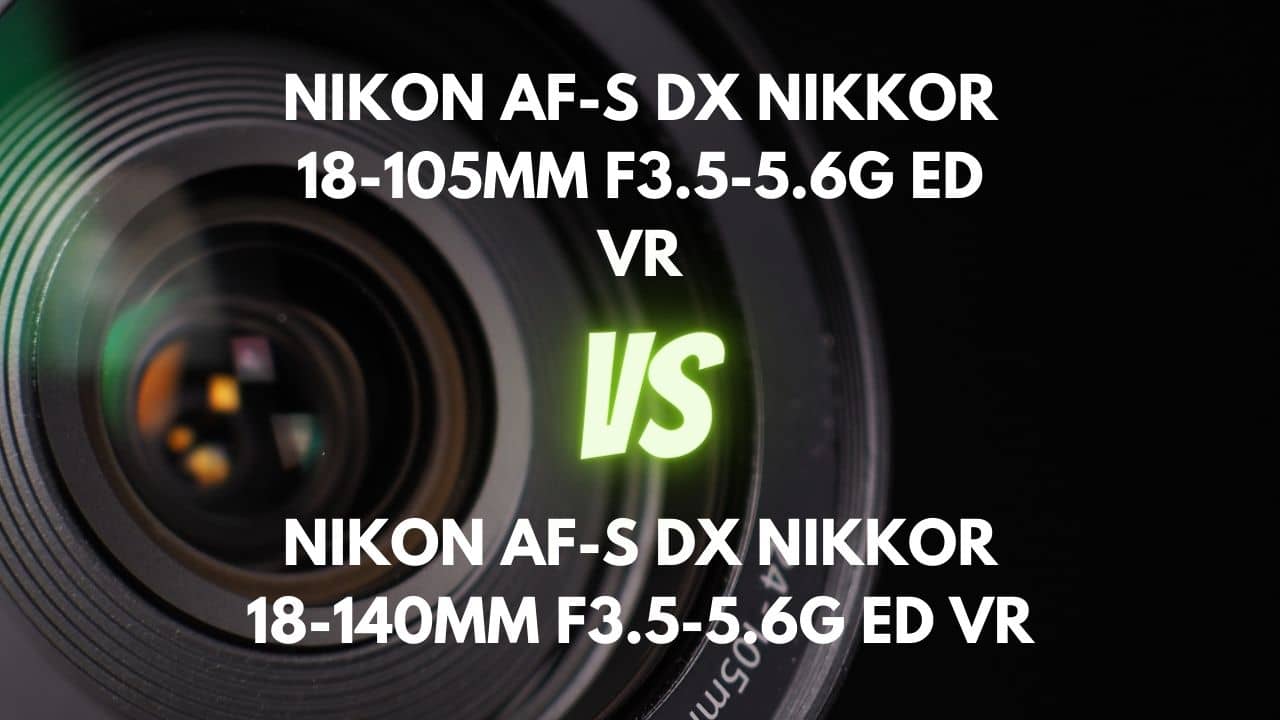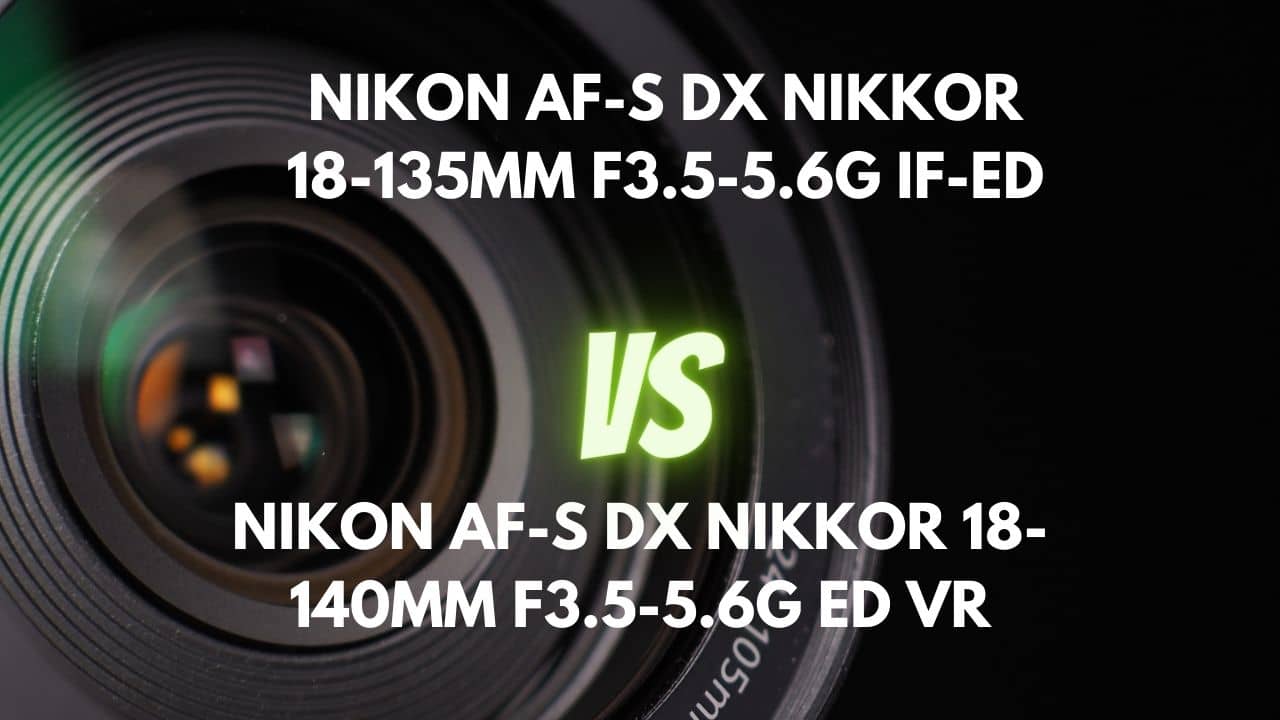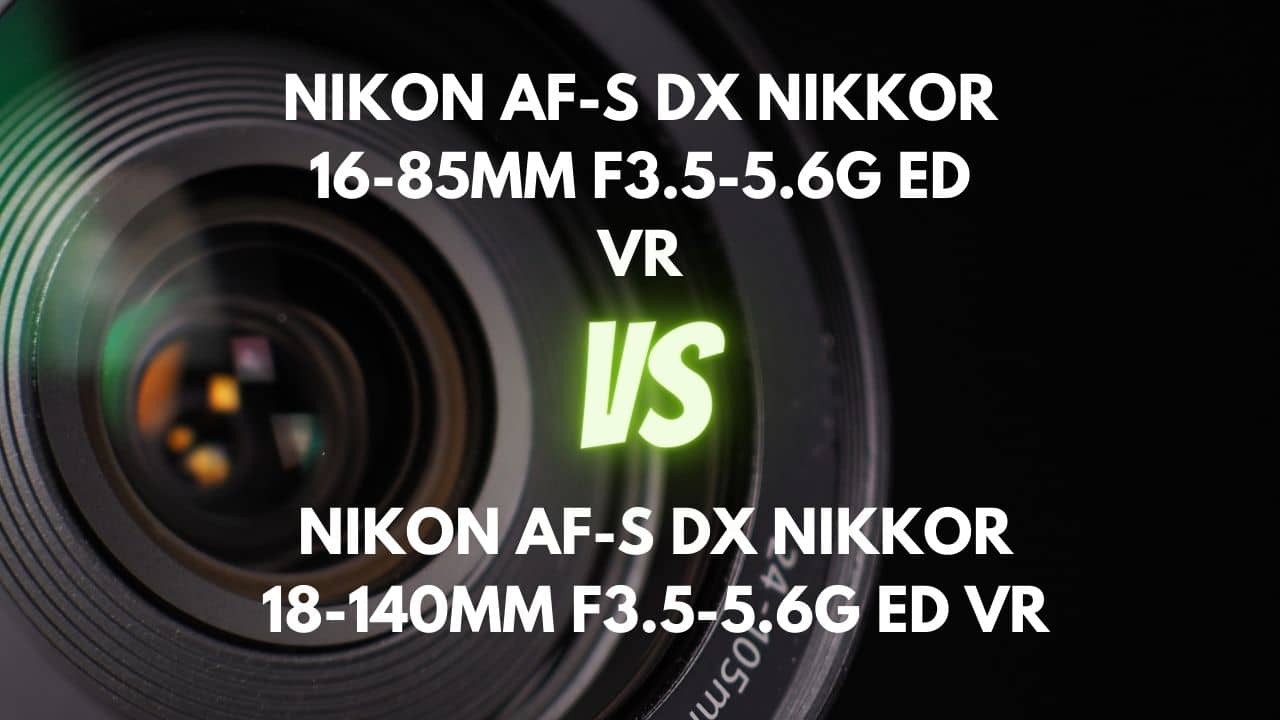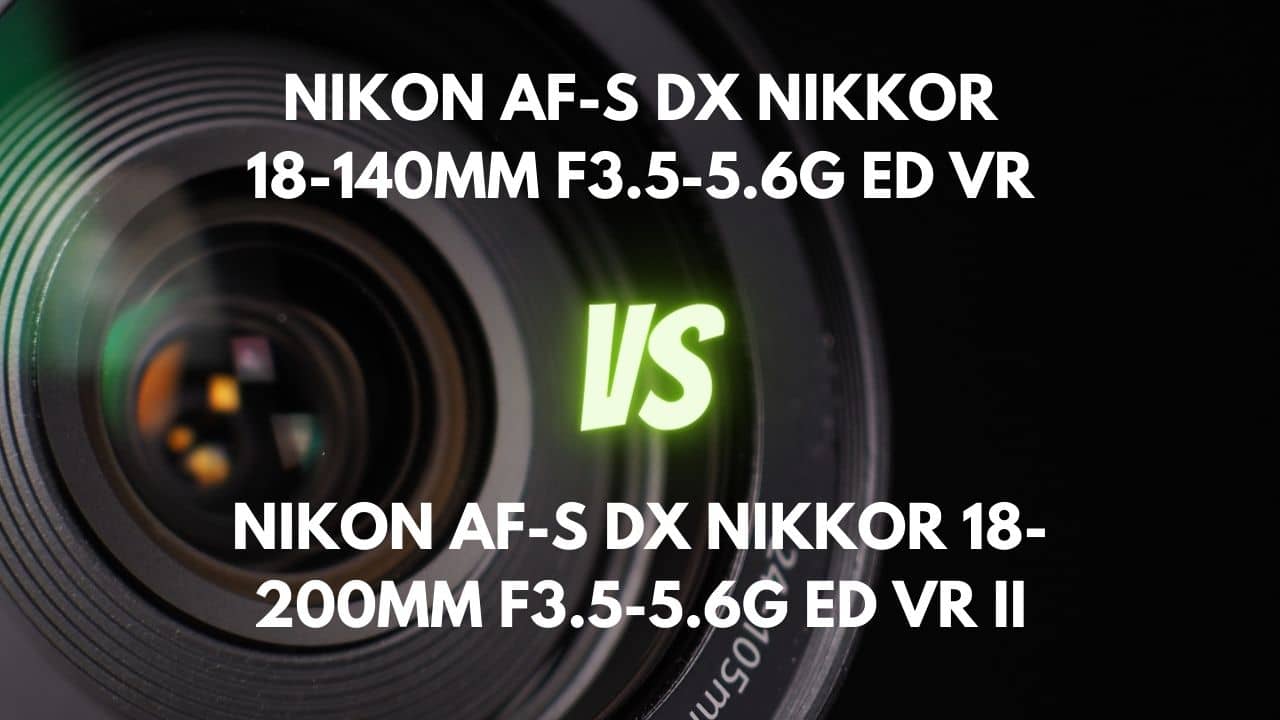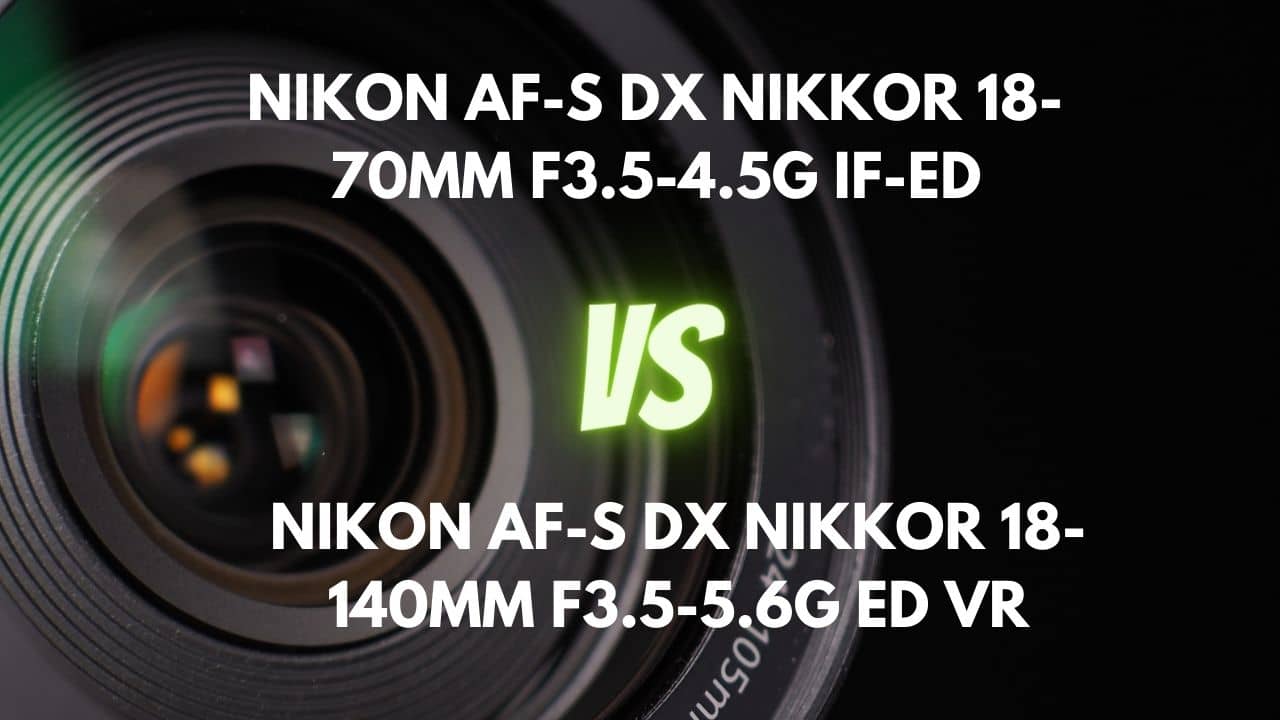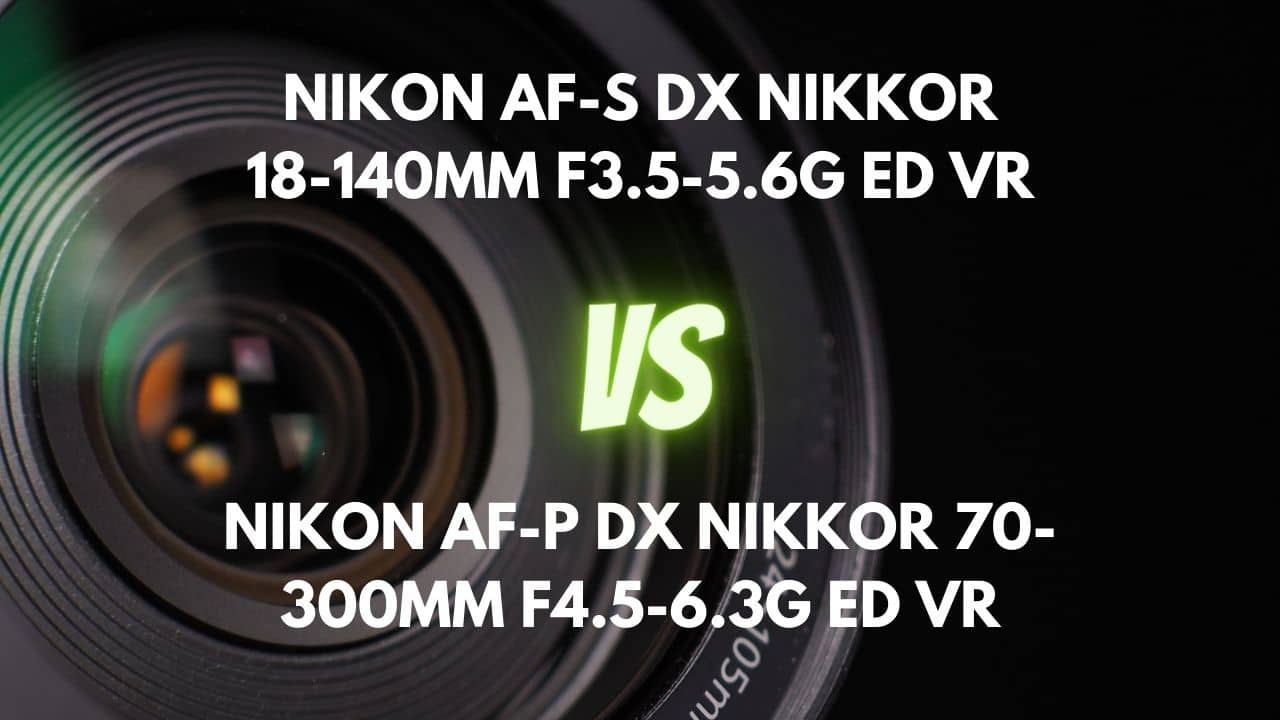Are you looking to elevate your photography game with a versatile and high-quality lens that can handle a wide range of scenarios? Look no further, as we bring you an in-depth comparison between two exceptional Nikon DX lenses: the 18-140mm f/3.5-5.6 and the 18-300mm f/3.5-6.3.
These lenses cater to photographers with diverse interests, be it capturing stunning landscapes, action-packed sports, intimate portraits, or documenting your adventurous travels.
In this article, we’ll delve into the nuances of these two lenses, comparing their performance in various aspects such as sharpness, focusing, distortion, and more.
By the end of our comparison, you’ll have a clearer understanding of which lens suits your style and requirements, empowering you to make an informed decision that will elevate your photographic skills.
So, join us as we explore the world of Nikon DX lenses and unravel the mysteries behind their unique features, helping you capture those picture-perfect moments with confidence and ease.
Let’s dive in and discover the perfect lens for your photography journey!
Overview
| Nikon AF-S DX NIKKOR 18-140mm F3.5-5.6G ED VR | Nikon AF-S DX NIKKOR 18-300mm F3.5-6.3G ED VR | |
|---|---|---|
| Max Aperture | F3.5-5.6 | F3.5-6.3 |
| Aperture Type | Variable | Variable |
| Focal Range (mm) | 18-140 | 18-300 |
| Max Format | APS-C / DX | APS-C / DX |
| Zoom Ratio (X) | 7.8 | 16.7 |
The Nikon DX 18-140mm f/3.5-5.6 and Nikon DX 18-300mm f/3.5-6.3 are 2 superzoom lenses that cater to different photography needs.
The 18-140mm has a maximum aperture of f/3.5-5.6 and a 7.8x zoom ratio, offering versatility for various shooting situations. On the other hand, the 18-300mm lens boasts a 16.7x zoom ratio and a slightly narrower maximum aperture of f/3.5-6.3, making it a great all-in-one option for photographers who want extended reach without constantly switching lenses.
In terms of low light performance, the 18-140mm lens has a slight advantage due to its marginally wider maximum aperture. However, both lenses are variable aperture lenses, which means their aperture size changes throughout the zoom range, affecting low light performance and depth of field. For photographers looking for better low light performance or more consistent aperture across the focal range, fixed aperture lenses could be an alternative.
While the 18-140mm lens offers a good balance between versatility and image quality, the 18-300mm lens provides an impressive focal range, making it a true all-rounder. This lens is especially well-suited for travel, wildlife, and sports photography, where a wide range of focal lengths is required. However, the trade-off is that the image quality and low light performance may not be as strong as those of a prime lens or a lens with a smaller zoom range.
In conclusion, the choice between the Nikon DX 18-140mm f/3.5-5.6 and the Nikon DX 18-300mm f/3.5-6.3 depends on your specific needs and preferences. If you prioritize versatility and a wide range of focal lengths in a single lens, the 18-300mm could be the superior choice. However, if you’re looking for a more balanced option that still provides flexibility without compromising too much on image quality and low light performance, the 18-140mm lens could be a better fit.
Design and Ease of Use
| Nikon AF-S DX NIKKOR 18-140mm F3.5-5.6G ED VR | Nikon AF-S DX NIKKOR 18-300mm F3.5-6.3G ED VR | |
|---|---|---|
| Diameter x Length (mm) | ⌀78×97mm | ⌀78.5×99mm |
| Weight (gr) | 490 | 550 |
| Filter Thread (mm) | 67 | 67 |
| Weather Sealing | No | No |
| Zoom Method | Rotary (extending) | Rotary (extending) |
| Distance Scale | No | No |
| DoF Scale | No | No |
| Hood Code | HB-32 | HB-39 |
Comparing the two lenses above, the Nikon DX 18-140mm f/3.5-5.6 has a diameter of 78mm and a length of 97mm, while the 18-300mm lens has a slightly larger diameter of 78.5mm and a length of 99mm. In terms of weight, the 18-140mm lens is lighter at 490 grams, whereas the 18-300mm lens weighs 550 grams. Both lenses feature a rotary (extending) zoom method.
The Nikon DX 18-300mm f/3.5-6.3 is more compact and lighter, which makes it easier to carry around, provides better balance, and allows for more portability in photography situations. On the other hand, the 18-300mm lens offers a greater zoom range, which may be beneficial for some photographers in need of versatility.
When considering the zoom method, both lenses utilize the extending rotary zoom, which is simpler and potentially lighter in weight. However, this design can make the lenses more cumbersome, more challenging to weather-seal, and may require more effort to maintain stability during shooting.
In conclusion, the 18-140mm lens is superior in terms of portability, balance, and discreetness, while the 18-300mm lens offers greater versatility in terms of focal range.
Lens Mount and Barrel
Comparing the two lenses, the lens mount of Nikon DX 18-140mm f/3.5-5.6 is made of metal without weather sealing or a rubber gasket. This makes it less resistant to moisture and dust compared to other lenses with a sealed mount. The majority of the lens barrel is constructed from polycarbonate plastic and showcases a zoom ring with a textured rubber grip, as well as a manual focus ring with a ridged rubber grip. The lens extends by just over 50mm when zooming from 18mm to 140mm and has no detectable wobbling.
On the other hand, the lens mount of Nikon DX 18-300mm f/3.5-6.3 is made of solid metal and includes a rubber gasket for added protection against dust and moisture. The lens barrel is mostly plastic with metal components and has a switch to lock the zoom at 18mm. The lens does not wobble when fully extended but can be more vulnerable to dust and moisture at longer focal lengths.
In conclusion, the 18-140mm lens mount and barrel are more suited for those prioritizing portability and affordability, while the 18-300mm lens mount and barrel offer better durability and protection against the elements.
Weather Sealing
The Nikon DX 18-140mm f/3.5-5.6 has no weather sealing, lacking a gasket at the lens mount and internal seals at the rings, switches, or front of the barrel. There’s also no fluorine coating on the front element. This lack of protection makes the lens unsuitable for use in harsh weather conditions or environments with high amounts of moisture and dust.
In contrast, the metal lens mount of the Nikon DX 18-300mm f/3.5-6.3 is equipped with a rubber gasket to prevent dust and moisture from entering the camera body. However, it is important to note that this lens is not marketed as being fully weatherproof, as there are no internal seals located at the rings and switches, nor is there a fluorine coating on the front element.
Weather sealing is essential for photographers who often shoot in challenging environments, as it provides protection against dust, moisture, and light water splashes. Lenses that are fully weather-sealed typically offer superior durability, performance, and protection when compared to their non-sealed counterparts. However, it is important to note that these lenses may be more expensive due to the additional materials and technology required to create the weather-resistant design.
In conclusion, the 18-300mm lens has superior weather sealing compared to the 18-140mm lens, offering better protection against dust and moisture. If you frequently shoot in harsh or unpredictable conditions, the 18-300mm lens may be a better option, providing valuable protection for your investment and peace of mind during your photography sessions.
Rings
The Nikon DX 18-140mm f/3.5-5.6 and 18-300mm lenses both feature 2 rings: a zoom ring and a focusing ring. In the 18-140mm lens, the zoom ring is situated near the front and occupies most of the barrel, covered in a thick, textured rubber grip band, providing good ergonomics.
The focusing ring, found behind the zoom ring, is narrower but still features a ridged rubber grip band. The zoom ring offers a pleasing resistance and is well-damped, while the focusing ring has a long throw, granting precise adjustments, but lacks much tactile feedback. Neither the windowed distance scale nor depth-of-field indicators are present in this lens.
On the other hand, the Nikon DX 18-300mm f/3.5-6.3 has a rubber-covered zoom ring at the front, ensuring excellent grip and smooth action. There is ample resistance to prevent zoom creep, and a lock switch is included for the 18mm setting.
The focus ring, made of rubbery plastic, is positioned closer to the camera body, allowing for easy adjustments and a smooth, well-damped action. The manual focusing distance is longer than most of its peers due to the geared focusing system, ensuring more accurate manual override of autofocus. The zoom ring takes more than half a turn to transition from 18 to 300mm, enabling swift zooming to a subject. However, this lens also lacks windowed distance scale and depth-of-field indicators.
In terms of ergonomics, precision, and control, the 18-300mm lens appears superior, with its smooth action, lock switch, and longer manual focusing distance. The build quality and compatibility with accessories are comparable for both lenses, but aesthetics may lean towards the 18-300mm lens due to its more streamlined design. Tactile feedback and ring placement are similar for both lenses, but the 18-300mm offers a quicker zooming experience.
In conclusion, the 18-300mm lens emerges as the superior choice, thanks to its better ergonomics, precision, and control. The added versatility of the longer zoom range also contributes to its appeal, making it an excellent choice for photographers seeking a single lens for a wide range of scenarios.
Switches/Buttons
The Nikon DX 18-140mm f/3.5-5.6 and 18-300mm lenses feature distinct switches and buttons, catering to different user preferences.
In the 18-140mm lens, there are two control switches located on the left side. The first switch enables or disables autofocus (A or M), offering users the choice between automatic and manual focusing. The second switch enables or disables vibration reduction (ON or OFF), providing stability for sharper images. The aperture is controlled via a mechanical lever, adding a touch of traditional functionality.
On the other hand, the Nikon DX 18-300mm f/3.5-6.3 comes with several switches and buttons, including an AF/MF switch, an IS switch, and a lock switch for the 18mm setting. The AF/MF switch enables manual override of autofocus, granting photographers more control over focusing. The IS switch turns the second-generation optical stabilization on or off, enhancing image stability.
The 18mm lock switch prevents zoom creep while carrying the camera, ensuring the lens stays in place. These switches and buttons are conveniently located and easy to use, with the AF/MF switch positioned on the left side of the lens and the IS and lock switches on the side of the lens barrel.
In conclusion, the 18-300mm lens offers superior switches and buttons due to its greater range of functions and user-friendly design. The addition of the IS switch and the 18mm lock switch make it a more versatile and convenient option for photographers who need a reliable lens for various shooting scenarios.
Filter Thread
The Nikon DX 18-140mm f/3.5-5.6 features a 67mm metal filter thread, which is compatible with 67mm diameter attachments. This thread remains stationary during focus or zoom operation, making it convenient for using filters such as graduated neutral density filters and polarizers. The front element is relatively flat and sits just behind the filter ring, while a small indicator mark on the filter ring’s outer edge guides the attachment of the optional bayonet-style lens hood.
In contrast, the Nikon DX 18-300mm f/3.5-6.3 has a 67mm plastic filter thread, which also doesn’t rotate on focus, allowing easy use with graduated filters and polarizers. Despite being lighter and more cost-effective, plastic filter threads are less durable than their metal counterparts. To protect the front element, it is recommended to use a UV or Protector filter.
When comparing the filter threads of these two lenses, the 18-140mm lens offers superior build quality with its metal filter thread, providing more durability and longevity. Both lenses share a 67mm filter thread size, ensuring compatibility with filters and reducing costs for photographers who may already own other lenses with the same thread size.
Lens Hood
The lens hood of Nikon DX 18-140mm f/3.5-5.6 is not included in the package and must be purchased separately. This plastic, petal-shaped hood comes with a bayonet mount, can be reversed for storage, and features an ergonomic bevel that allows for smooth rotation. The lens hood primarily serves to prevent lens flare and protect the front element of the lens from impacts.
On the other hand, the Nikon DX 18-300mm f/3.5-6.3 also has a petal-shaped hood, but it is sold separately as an optional accessory. Made of plastic, it has a decent bevel for ergonomic handling and shields the front element from extraneous light, which may cause flare or loss of contrast. Like the 18-140mm lens hood, it can be smoothly rotated.
Comparing the two lens hoods, both offer similar functionality and design, with petal-shaped hoods and smooth rotation some users.
Focusing and Optical Stabilization
| Nikon AF-S DX NIKKOR 18-140mm F3.5-5.6G ED VR | Nikon AF-S DX NIKKOR 18-300mm F3.5-6.3G ED VR | |
|---|---|---|
| Autofocus | Yes | Yes |
| AF Motor | Silent Wave Motor | Silent Wave Motor |
| Rotating Front Element | Does not rotate on focusing | Does not rotate on focusing |
| Min Focus Distance | 0.45m | 0.48m |
| Max Magnification (X) | 0.23 | 0.32 |
| Full-Time Manual Focus | Yes | Yes |
| Focus Method | Internal | Internal |
Focusing Performance
The Nikon DX 18-140mm f/3.5-5.6 offers an ultrasonic Silent Wave Motor for autofocus, ensuring a reasonably fast, very quiet, and almost silent operation. It performs well in both single-servo autofocus and continuous autofocus modes.
The lens provides manual focus override by simply turning the focus ring for a smooth focusing experience. Its internally focusing design ensures that the lens length remains constant, and the front element does not rotate during focusing. At closer focusing distances, particularly towards the longer end of the zoom range, the lens may demonstrate focus breathing – a phenomenon where the image appears to decrease in size as the lens is focused more closely.
In contrast, the Nikon DX 18-300mm f/3.5-6.3 features quiet and accurate autofocus performance at short focal lengths due to the AF-S Silent Wave Motor. Autofocus accuracy may become less consistent as the lens is zoomed in, particularly beyond 105mm, and this may be especially pronounced at 200mm and 300mm focal lengths.
While the autofocus speed of the lens is relatively fast, it may not be as quick as that of professional-grade lenses. Additionally, the autofocus may occasionally slow down and struggle to find focus in low-light environments, leading to hunting behavior. The lens offers manual focus override via the narrow focusing ring, which is well-damped and allows for smooth fine adjustments. Similar to the 18-140mm lens, the 18-300mm lens also exhibits focus breathing.
Comparing the two lenses, the 18-140mm lens boasts superior focusing performance, with a faster, quieter, and more consistent autofocus operation across its zoom range. The 18-300mm lens suffers from inconsistent autofocus accuracy at longer focal lengths and slower performance in low-light situations. Both lenses allow for manual focus override and experience focus breathing. Overall, the 18-140mm lens outperforms the 18-300mm lens in terms of focusing performance, making it a better choice for capturing sharp images, particularly in situations where fast and accurate focus is essential.
Optical Stabilization
The Nikon DX 18-140mm f/3.5-5.6 features Nikon’s Vibration Reduction (VR) technology, providing up to 4 stops of compensation for hand-held shake. The stabilization slider on the lens offers two options: on and off. When turned on, the built-in VR (vibration reduction) system is quite effective, allowing photographers to shoot hand-held at slow shutter speeds – for example, at 1/15 second with a focal length of 140mm – and still achieve sharp results in approximately half of the shots captured.
In contrast, the Nikon DX 18-300mm f/3.5-6.3 features Nikon’s Vibration Reduction system, which can provide up to 4 stops of stabilization. This allows for the use of slower shutter speeds without noticeable camera shake. Additionally, the VR mechanism operates quietly, making it suitable for use in a variety of shooting scenarios.
When shooting at wide-angle focal lengths, the stabilization system performs admirably, allowing for sharp handheld shots even at shutter speeds as slow as 1/2 second. However, at telephoto focal lengths, the VR system may be less effective, and the ideal shutter speed may vary depending on the photographer’s technique and level of stability.
In comparison, both lenses have a similar optical stabilization performance, with up to 4 stops of compensation provided by Nikon’s Vibration Reduction technology. The 18-140mm lens delivers efficient stabilization at its longest focal length, while the 18-300mm lens performs well at wide-angle settings. However, the 18-300mm lens experiences reduced effectiveness at telephoto focal lengths.
Overall, the optical stabilization performance of these lenses is quite comparable, with neither lens having a clear advantage over the other in terms of optical stabilization.
Image Quality
| Nikon AF-S DX NIKKOR 18-140mm F3.5-5.6G ED VR | Nikon AF-S DX NIKKOR 18-300mm F3.5-6.3G ED VR | |
|---|---|---|
| Special Elements | 1 ED (extra-low dispersion) glass element, 1 aspherical lens element | 3 ASPH |
| Diaphragm Blades | 7 | 7 |
| Circular Aperture | No | Yes |
Aberration
The Nikon DX 18-140mm f/3.5-5.6 displays chromatic aberration, which is more noticeable in this model than in previous Nikon lenses. Nevertheless, it is generally not a major issue, with slight dark blue fringing appearing around high-contrast areas in the corners of test images. Coma performance is excellent for the 18-140mm lens, exhibiting no visible smeared blobs around bright points of light, even in the corners of the image.
In contrast, the Nikon DX 18-300mm f/3.5-6.3 shows varying levels of chromatic aberration throughout its zoom range. Fringing is most prevalent towards the edges of the frame at 300mm, where it can exceed 2 pixel widths.
However, automatic in-camera corrections or post-processing software, such as Adobe Lightroom, can effectively eliminate this issue. The lens also demonstrates good performance with regard to coma, as there is no noticeable smearing or distortion around bright points of light in the corners of the frame when using large apertures.
In conclusion, both lenses exhibit chromatic aberration, with the 18-300mm lens having slightly more noticeable fringing at its longest focal length. However, both lenses can effectively manage this issue with in-camera corrections or post-processing software. In terms of coma performance, both lenses perform admirably, with no significant issues detected.
Sharpness
In terms of sharpness, the Nikon DX 18-140mm f/3.5-5.6 exhibits strong performance, with excellent center sharpness even at wider apertures and further improvement upon stopping down to f/5.6 and beyond. However, corner sharpness may be slightly softer, particularly at wider angles.
Stopping down to around f/8 can result in a significant improvement in corner sharpness. The optimal aperture for achieving the sharpest results may vary depending on the focal length, but generally, f/8 and f/11 tend to provide the best performance. However, it is important to note that diffraction effects may start to become noticeable around f/8, and can become a more significant issue at apertures of f/16 or smaller.
In contrast, the sharpness of the Nikon DX 18-300mm f/3.5-6.3 can vary depending on the focal length and aperture, with the weakest performance being at the widest apertures. While the center of the frame is generally quite sharp, even when shooting wide open, sharpness may drop off progressively at longer zoom settings.
Corner sharpness is particularly disappointing at longer focal lengths. Stopping down the lens can lead to a significant improvement in sharpness across the entire frame, with exceptional center sharpness and excellent edge sharpness being achieved between apertures of f/8 and f/11.
In conclusion, the 18-140mm lens offers more consistent sharpness performance, especially at wider angles, while the 18-300mm lens requires stopping down to achieve better results. Although both lenses have their strengths and weaknesses, the 18-140mm lens appears to deliver superior overall sharpness, making it the better choice for photographers who prioritize image clarity across a range of focal lengths.
Bokeh Quality
The Nikon DX 18-140mm f/3.5-5.6 lens is equipped with an iris diaphragm containing 7 blades, resulting in a bokeh effect that some may consider slightly nervous or busy. The quality of the bokeh is subjective and can vary from decent to good, depending on factors such as focusing distance, focal length, and aperture settings. To produce the softest backgrounds, it is suggested to step back and zoom in to the longest possible focal length of 140mm at an aperture of f/5.6.
The Nikon DX 18-300mm f/3.5-6.3 showcases good bokeh performance, particularly when shooting at longer focal lengths and wider apertures. The lens features a 7 rounded blade iris diaphragm, which helps to produce smooth, attractive bokeh in out-of-focus areas of the image. However, the quality of bokeh is subjective and varies depending on the zoom setting, aperture, and focus distance. While the lens is not renowned for producing creamy and beautiful bokeh, other lenses may be preferred for that specific purpose.
In conclusion, both lenses offer fairly similar bokeh quality, with neither being exceptional in this aspect. The 18-300mm lens may provide slightly smoother bokeh at longer focal lengths and larger apertures, but the difference is not significant.
Flare/Ghosting
The Nikon DX 18-140mm f/3.5-5.6 demonstrates minimal flare and ghosting in most situations, thanks to Nikon’s Integrated Coating, which reduces these optical anomalies. It is worth noting that when shooting directly into the sun or other bright light sources, some ghosting may be visible in the resulting images captured with this lens.
The optional petal-shaped lens hood (HB-32) can help to reduce the likelihood of both flare and ghosting when using the Nikon DX 18-140mm f/3.5-5.6 lens. While ghosting may still occur, its presence can be mitigated to some degree by using the hood. It is worth noting that the number of ghosts that appear in images may vary depending on the lens being used, with fewer ghosts typically being present when using a fixed lens and more ghosts potentially appearing when using an older single-coated zoom lens.
On the other hand, the Nikon DX 18-300mm f/3.5-6.3 manages ghosting and flare quite well, depending on the focal length and light source placement. Even when shooting directly into the noontime sun with a UV filter over the lens, there are no significant flare or ghosting issues.
The Nikon DX 18-300mm f/3.5-6.3 lens demonstrates outstanding performance when it comes to controlling ghosting and flare, even under difficult shooting conditions. However, as the lens is zoomed in towards the telephoto range, ghosting may become more pronounced, particularly when pointing the lens towards a light source such as the sun located outside the frame. In such situations, veiling and contrast loss can occur, and it may be necessary to take extra care when composing shots to avoid these issues.
In conclusion, both lenses perform well in terms of flare and ghosting control, with the 18-300mm lens showing slightly better performance in challenging light conditions. However, as you zoom towards the telephoto range, ghosting can become more of an issue with the 18-300mm lens.
Vignetting
Vignetting can be noticeable when using the Nikon DX 18-140mm f/3.5-5.6 lens, particularly at certain focal lengths, and this effect may be more pronounced when in-camera correction is disabled. Vignetting tends to become more noticeable towards the ends of the zoom range when using the Nikon DX 18-140mm f/3.5-5.6 lens, rather than in the middle. To reduce or minimize vignetting, it may be helpful to stop down the aperture to around f/5.6 or f/8, which can help to brighten up the corners of the image.
In contrast, the Nikon DX 18-300mm f/3.5-6.3 displays noticeable vignetting at wider apertures, especially at the extreme corners. While vignetting can be noticeable when shooting with the Nikon DX 18-140mm f/3.5-5.6 lens, it can be corrected quite easily during post-processing. It is worth noting that stacking filters may lead to some slight vignetting, particularly when using the lens at its widest setting. In general, vignetting tends to be more of an issue when shooting wide open, and stopping down the aperture to f/8 or smaller can help to produce more consistent illumination across the frame throughout the entire zoom range.
In conclusion, both lenses experience some degree of vignetting, with the 18-140mm lens showing more prominence towards the ends of the zoom range, while the 18-300mm lens displays vignetting mainly at wider apertures. Stopping down the aperture helps minimize vignetting in both cases.
Distortion
Distortion can be noticeable when using the Nikon DX 18-140mm f/3.5-5.6 lens, particularly at wider focal lengths. At 18mm, there may be noticeable barrel distortion, while at focal lengths between 35mm and 140mm, pincushion distortion may be visible. However, it is worth noting that in-camera distortion correction is available, and many post-processing software packages are also capable of correcting this issue. Some users may find it helpful to enable Auto Distortion Correction in the camera’s menu to help mitigate this effect.
The Nikon DX 18-300mm f/3.5-6.3 lens showcases notable distortion across its entire zoom range, with barrel distortion being most pronounced at 18mm and pincushion distortion becoming more noticeable from 28mm onwards. Although distortion can be corrected in post-processing using software like Adobe Lightroom, in-camera correction may be preferred for JPEG capture. However, it’s important to note that this correction process may lead to some loss of picture information at the edges of the frame.
In conclusion, both lenses exhibit noticeable distortion, but the 18-300mm lens seems to have more pronounced distortion throughout its zoom range compared to the 18-140mm lens. Although distortion can be corrected for both lenses using in-camera settings or post-processing software, the 18-140mm lens appears to have a slight advantage due to its less pronounced distortion, making it the superior choice in terms of distortion control.
Final Verdict
Taking all the factors into consideration, the choice between the Nikon DX 18-140mm f/3.5-5.6 and the Nikon DX 18-300mm f/3.5-6.3 depends on your specific needs and preferences. The primary difference between these two lenses lies in their focal length range, which can affect the types of photography you plan on pursuing.
The 18-300mm lens is ideal for photographers who prioritize versatility and a wide range of focal lengths in a single lens, making it suitable for various scenarios such as landscapes, wildlife, and travel photography. This lens also has better weather sealing and slightly superior flare/ghosting control, providing added protection and performance in harsh conditions.
On the other hand, the 18-140mm lens offers a more balanced and portable option that still provides flexibility without compromising too much on image quality and low light performance. This lens is more suited for photographers who prioritize portability, affordability, and faster focusing performance, making it an excellent choice for everyday photography and capturing fast-moving subjects.
Both lenses have their strengths and weaknesses in terms of optical performance, such as sharpness, bokeh, vignetting, and distortion. While neither lens stands out significantly in these areas, the 18-140mm lens has a slight edge in terms of sharpness and distortion control.
In conclusion, if you value versatility and a broader focal length range, the 18-300mm lens would be the better choice. However, if you prefer a more portable, affordable, and faster focusing lens without sacrificing much in terms of optical performance, the 18-140mm lens would be a better fit. The final decision ultimately depends on your photography goals and the types of subjects you plan to capture.

